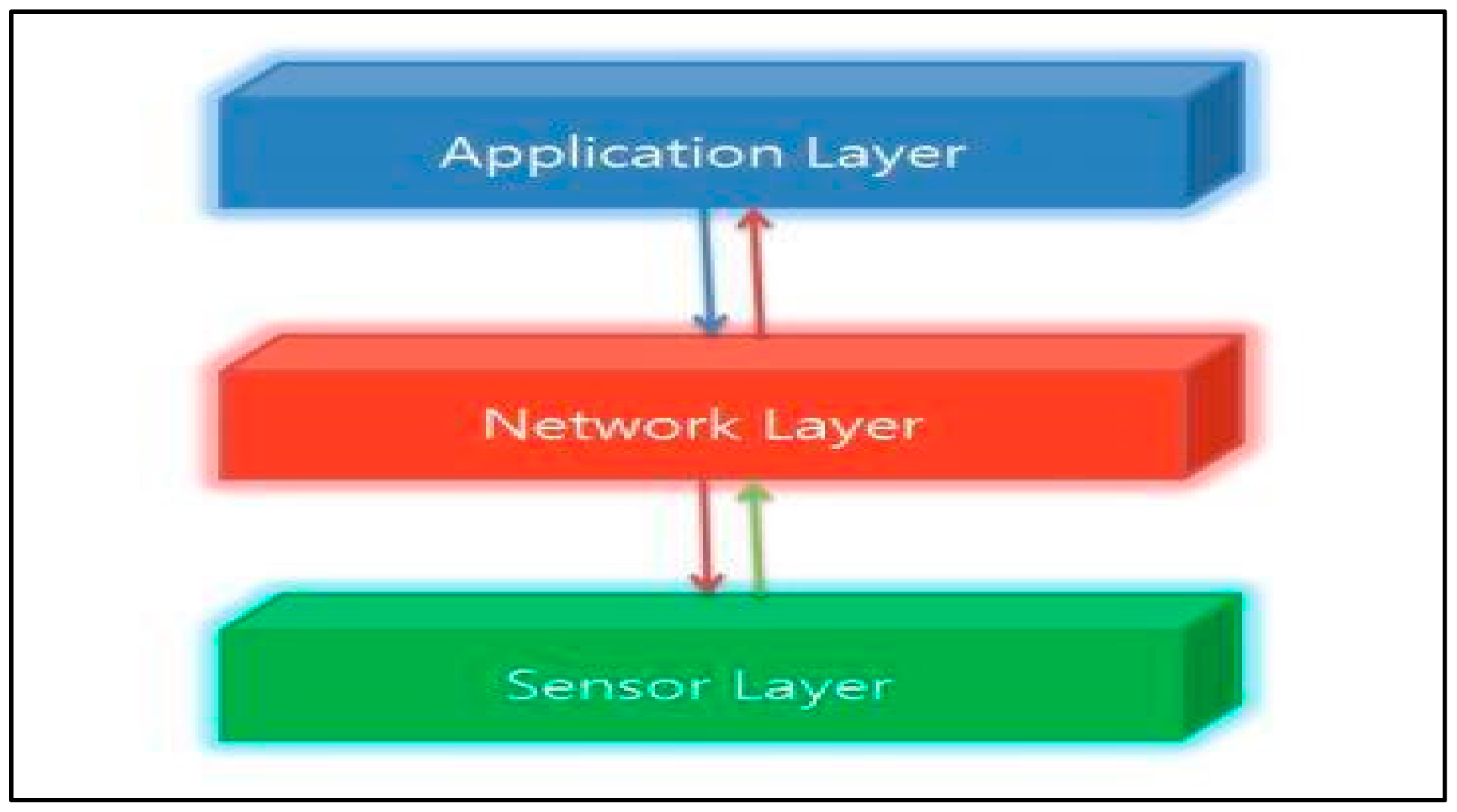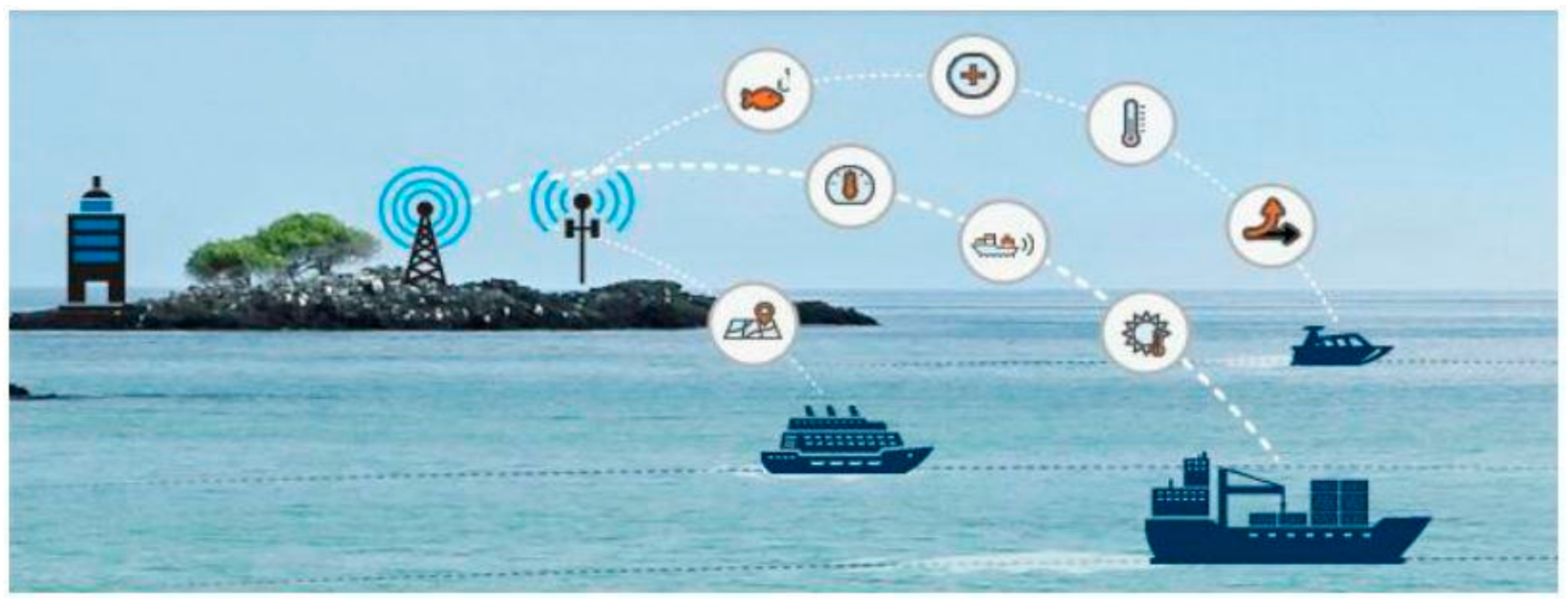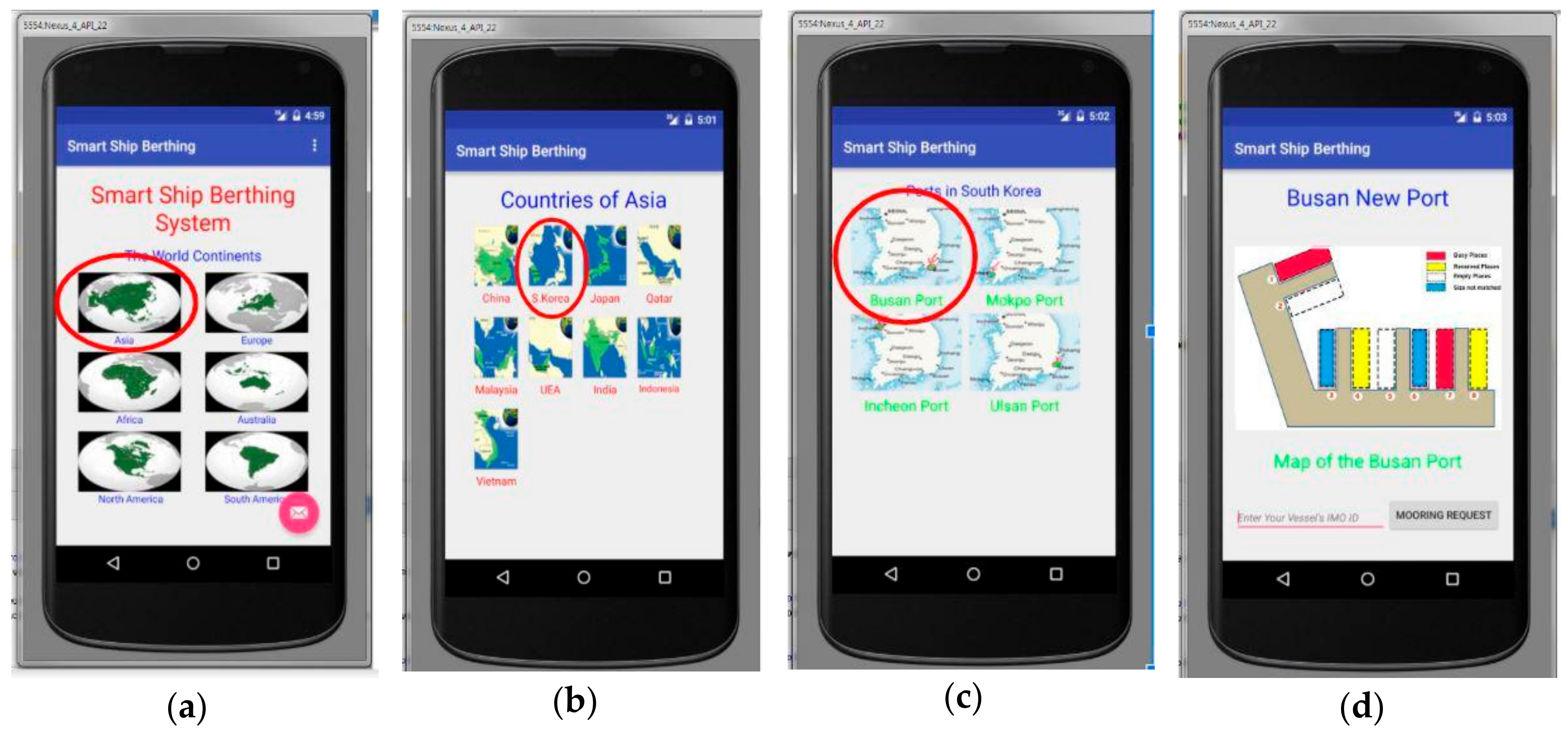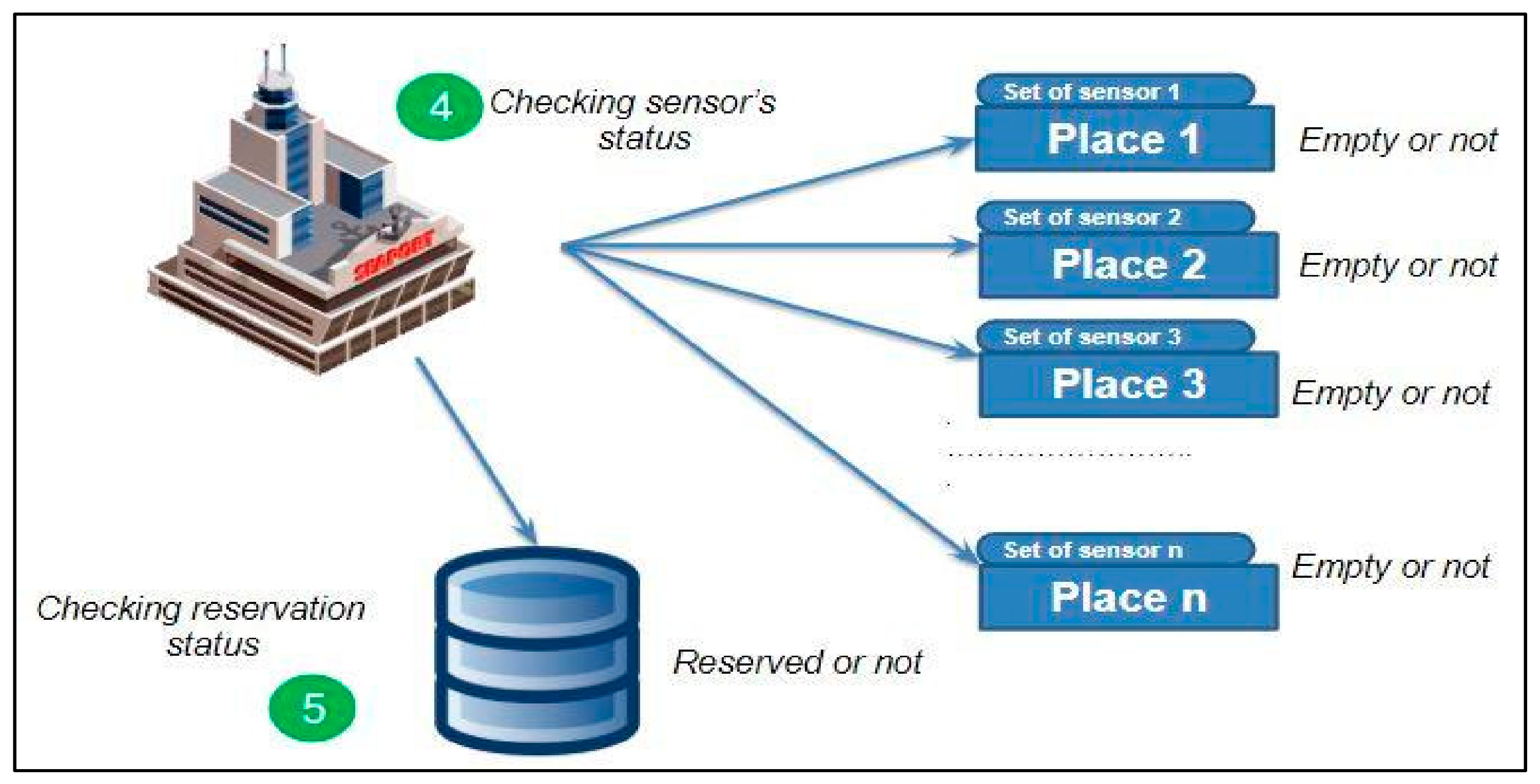An IoT-Based Ship Berthing Method Using a Set of Ultrasonic Sensors †
Abstract
:1. Introduction
2. Related Works
2.1. Internet of Things—IoT
2.1.1. Main Architectures of the IoT
- Application Layer
- Network Layer
- Sensor Layer
Application Layer
Transmission Layer
Sensor Layer
2.1.2. IoT Elements and Technologies
- Identification
- Feeling Things
- Communication Technologies
- Computation and Management
- IoT Services
- Semantics
2.2. IoT, Cloud, BigData in the Marine
2.2.1. Smart Ships
2.2.2. Smart Ports
2.2.3. Big Data and Cloud in Shipping
2.3. Related Works
3. Problem Analysis in Ship Berthing
4. Proposed System
4.1. Architecture
4.1.1. Smart Berthing System for Ships (Application Layer)
4.1.2. Smart Berthing System for Ships (Network Layer)
4.1.3. Sensor Layer of the Smart Berthing System for Ships
4.2. High-Level Design
4.3. Working Scenario
- Step 1: hips arriving at the port access the port system through the network for instance, using 5G, LTE (LTE-M, LTE-A), Wi-Fi, or WiMAX. When the ship arrives near the port, it sends a connection request to the port.
- Step 2: After receiving a successful response from the port, the ship can send data (information about the ship) and ask for a place to berth.
- Step 3: The port will receive and check the data which is sent from the ship. Figure 7 shows our system scenario from Step 1 to Step 3.
- Step 4: After the port receives the data about the ship, the system at the port will get information about the availability of berthing places using a set of ultrasonic sensors placed in certain locations. The port system sorts places into busy places, empty places, not matched places and reserved places.
- Step 5: After obtaining data on the available vacancies, the system takes into account the reserved places that were requested by ships that arrived at the port earlier and do not match places where the size of the ship does not match the berth. Figure 8 illustrates Step 4 to Step 5 during sorting.
- Step 6: All the collected data concerning the vacancies is sorted and the perfect place location is sent to the ship. The system sends all information about this optimal vacancy such as location and number on a digital map. After sending the place information system it awaits confirmation messages from the ship.
- Step 7: The data regarding the places available for the berthing and the area shown on the port map are sent to the ship. Once a vessel has reserved a place described in the message sent from the port, it will receive a reserved place status. Figure 9 illustrates the system scenario from Step 6 to Step 7.
4.3.1. Proposed System in the Ship
- All static information about the ship is transferred to the system in advance and it is stored constantly (the model, type, color, length, name, owner of the ship, etc.). Moreover, the system keeps all the data about the ports and target places to berth (coordinates, maps, etc.).
- The system receives continuous information with the help of the sensors fixed on the ship (the direction, speed, location, temperature, etc. of the ship).
- The system offers the opportunity for the responsible person (he may be a captain) to add and save the data.
4.3.2. Proposed System at the Port
- All the static data about possible berthing places and set of sensors is inserted into the system beforehand and it is kept constantly (the measurements of the berths, type of berth, location, number, the ID which is assigned to a set of sensors, etc.).
- The system receives data continuously via the set of ultrasonic sensors that are fixed at different places (is the place vacant or occupied and if it is occupied, it clarifies which ship has been moored there).
- Getting the data taken from a set of sensors the system determines vacant and convenient spacea and it sends the information about the place to a certain ship (the number of the place, location, type of place, etc.).
- The system, before sending the data about vacant places to a certain ship via sensors checks the information of the ships which have reserved the place beforehand and then those places are sorted out from the list. The system sorts berths by the size and type of the ships. Because longer vessels need longer berths and smaller ones need less space. Passenger or cargo ships need particular types of place at the port.
4.3.3. Communication Technologies
5. Implementation and Experiment
6. Results
7. Discussion
8. Conclusions
Author Contributions
Funding
Conflicts of Interest
Appendix A. An Example of a Current Ship and Port Reporting Conversation
References
- Kamolov, A.; Al-Absi, M.A.; Lee, H.J.; Park, S.H. Smart Flying Umbrella Drone on Internet of Things: AVUS. In Proceedings of the 21st International Conference on Advanced Communication Technology (ICACT), PyeongChang Kwangwoon_Do, Korea, 17–12 February 2019. [Google Scholar]
- Al-Absi, M.A.; Kamolov, A.; Kim, K.; Al-Absi, A.A.; Sain, M.; Lee, H.J. Labs and Classes: An Iot Design and Implementation. In Proceedings of the International Association for Convergence Science & Technology (ICAST), Shaoxing, China, 15–18 November 2018. [Google Scholar]
- Hyundai Heavy Industries Debuts ‘Smart Ship’ Solution. Available online: https://www.marine link.com/news/industriessolution427522 (accessed on 9 July 2019).
- Japan Develops Smart Ship Platform. Available online: http://www.marinemec.com/news/view,japan-develops-smart-shipplatform_44850.htm (accessed on 11 January 2019).
- We4Sea Approved for MRV Compliance. Available online: www.we4sea.com (accessed on 21 November 2019).
- Oceanstar. Available online: https://www.fugro.com/our-services/marine-asset-integrity/satellite-positioning/oceanstar (accessed on 9 July 2019).
- Weiser, M. The Computer for the 21st Century. Sci. Am. 1991, 265, 94–105. [Google Scholar] [CrossRef]
- Uckelmann, D.; Harrison, M.; Michahelles, F. An Architectural Approach Towards the Future Internet of Things. In Architecting the Internet of Things; Springer: Heidelberg, Germany, 2011; pp. 1–24. [Google Scholar]
- Kuyoro, S.; Osisanwo, F.; Akinsowon, O. Internet of Things (IoT): An Overview. In Proceedings of the 3rd International Conference on Advances in Engineering Sciences & Applied Mathematics, London, UK, 23–24 March 2015. [Google Scholar]
- Who Needs the Internet of Things? Available online: https://www.linux.com/news/who-needs-internet-things (accessed on 9 July 2019).
- 21 Open Source Projects for IoT. Available online: https://www.linux.com/NEWS/21-OPEN-SOURCE-PROJECTS-IOT (accessed on 9 July 2019).
- Internet of Thing. Available online: https://en.wikipedia.org/wiki/Internet_of_things (accessed on 9 July 2019).
- Popular Internet of Things Forecast of 50 Billion Devices by 2020 Is Outdated. Available online: https://spectrum.ieee.org/tech-talk/telecom/internet/popular-internet-of-things-forecast-of-50-billion-devices-by-2020-is-outdated (accessed on 9 July 2019).
- The Internet of Things: Sizing up the Opportunity. Available online: https://www.mckinsey.com/industries/semiconductors/our-insights/the-internet-of-things-sizing-up-the-opportunity (accessed on 9 July 2019).
- The Internet of Things, Gateways, and Next Generation of APIs Speaker Session at APIStrat Austin. Available online: https://dzone.com/articles/the-internet-of-things-gateways-and-next-generatio (accessed on 9 July 2019).
- Best Internet of Things Definition. Available online: https://www.postscapes.com/internet-of-things-definition/ (accessed on 9 July 2019).
- The Internet of Things. Available online: https://www.mckinsey.com/industries/high-tech/our-insights/the-internet-of-things (accessed on 9 July 2019).
- Mahmoud, R.; Yousuf, T.; Aloul, F.; Zualkernan, I. Internet of Things (IoT) security: Current status, challenges and prospective measures. In Proceedings of the 2015 10th International Conference for Internet Technology and Secured Transactions (ICITST), London, UK, 14–16 December 2015. [Google Scholar]
- Lin, J.; Yu, W.; Zhang, N.; Yang, X.; Zhang, H.; Zhao, W. A Survey on Internet of Things: Architecture, Enabling Technologies, Security and Privacy, and Applications. IEEE Internet Things J. 2017, 4, 1125–1142. [Google Scholar] [CrossRef]
- Tan, L.; Wang, N. Future Internet: The Internet of Things. In Proceedings of the 2010 3rd International Conference on Advanced Computer Theory and Engineering (ICACTE), Chengdu, China, 20–22 August 2010; Volume 5, pp. V5376–V5380. [Google Scholar]
- Wu, M.; Lu, T.J.; Ling, F.Y.; Sun, J.; Du, H.Y. Research on the architecture of Internet of Things. In Proceedings of the 3rd International Conference on Advanced Computer Theory and Engineering (ICACTE), Chengdu, China, 20–22 August 2010; Volume 5, pp. 484–487. [Google Scholar]
- Chuah, J.W. The Internet of Things: An Overview and New Perspectives in Systems Design. In Proceedings of the International Symposium on Integrated Circuits (ISIC), Singapore, 10–12 December 2014. [Google Scholar]
- Ala, A.; Mohsen, G.; Mehdi, M.; Mohammed, A.; Moussa, A. Internet of Things: A Survey on Enabling Technologies, Protocols, and Applications. IEEE Commun. Surv. Tutor. 2015, 17, 2347–2376. [Google Scholar]
- Koshizuka, N.; Sakamura, K. Ubiquitous ID: Standards for Ubiquitous computing and the Internet of Things. IEEE Pervasive Comput. 2010, 9, 98–101. [Google Scholar] [CrossRef]
- Internet of Things: Empowered by Auto-ID Technologies. Available online: https://www redbite.com/auto-id-technologies/ (accessed on 9 July 2019).
- Kushalnagar, N.; Montenegro, G.; Schumacher, C. IPv6 over Low-Power Wireless Personal Area Networks (6LoWPANs): Overview, Assumptions, Problem Statement, and Goals; RFC 4919; IETF: Fremont, CA, USA, 2007. [Google Scholar]
- Montenegro, G.; Hui, J.; Culler, D.; Kushalnagar, N. Transmission of IPv6 Packets over IEEE 802.15.4 Networks; IETF Secretariat: Fremont, CA, USA, 2007. [Google Scholar]
- Internet of Things (IoT) Sensors and Connectivity. Available online: https://www c-sharpcorner.com/article/internet-of-things-iot-sensors-and-connectivity/ (accessed on 9 July 2019).
- 11 Internet of Things (IoT) Protocols You Need to Know about. Available online: https://www rs-online.com/designspark/eleven-internet-of-things-iot-protocols-you-need-to-know-about (accessed on 9 July 2019).
- Communication Technologies for Iot. Available online: https://iotfuse.com/communication-technologies-for-iot/ (accessed on 1 January 2018).
- Al-Sarawi, S.; Anbar, M.; Alieyan, K.; Alzubaidi, M. Internet of Things (IoT) Communication Protocols: Review. In Proceedings of the 2017 8th International Conference on Information Technology (ICIT), Amman, Jordan, 17–18 May 2017; pp. 685–690. [Google Scholar]
- Arduino Uno Vs. BeagleBone Vs. Raspberry Pi. Available online: https://makezine.com/2013/04/15/arduino-uno-vs-beaglebone-vs-raspberry-pi/ (accessed on 9 July 2019).
- How Intel’s Edison Stacks Up against Arduino and Raspberry Pi. Available online: https://readwrite.com/2014/09/10/intel-edison-raspberry-pi-arduino-comparison/ (accessed on 9 July 2019).
- Linkit One Vs. Edison Vs. Raspberry Pi Vs. Beaglebone Black. Available online: https://www.seeedstudio.com/blog/2014/10/31/linkit-one-vs-edison-vs-raspberry-pi-vs-beaglebone-black/ (accessed on 9 July 2019).
- Raspberry Pi stays High in 2015 Hacker SBC Survey. Available online: http://linuxgizmos.com/raspberry-pi-stays-sky-high-in-2015-hacker-sbc-survey (accessed on 9 July 2019).
- Arduino TRE. Available online: https://www.arduino.cc/en/Main/ArduinoBoardTre (accessed on 9 July 2019).
- Kamolov, A.; Park, S.H. IoT based smart reporting and mooring system for vessels. In Proceedings of the Korean Institute of Information and Communication Sciences Conferece Chungcheongnam-do, Korea, 10 October 2017; Volume 21, pp. 0395–0398. [Google Scholar]
- Xiaojiang, X.; Jianli, W.; Mingdong, L. Services and Key Technologies of the Internet of Things; ZTE Communications: Shenzhen, China, 2010; Volume 2, p. 011. [Google Scholar]
- Gigli, M.; Koo, S. Internet of things: Services and applications categorization. Adv. Internet Things 2011, 1, 27–31. [Google Scholar] [CrossRef]
- The World’s First Smart Ship “I-Dolphin Unveiled”. Available online: https://www.marineinsight.com/shipping-news/the-worlds-first-smart-ship-i-dolphin-unveiled/ (accessed on 9 July 2019).
- World’s First Smart Ship Developed and Built in China. Available online: http://www.chinadaily.com.cn/china/2017-11/03/content_34055628.htm (accessed on 9 July 2019).
- Arriving at a Port. Available online: https://www.pfri.uniri.hr/bopri/documents/21-MEArrivalataport_000.pdf (accessed on 9 July 2019).
- SMART-Navigation. Available online: http://www.smartnav.org/html/SMARTNavigation/about_smart_navigation.php (accessed on 9 July 2019).
- Hamburg Port. Available online: https://www.hafen-hamburg.de/en/portmap (accessed on 9 July 2019).
- Amsterdam Port. Available online: https://www.portofamsterdam.com/en/shipping/arrivals-and-departures (accessed on 9 July 2019).
- Al-Absi, M.A.; Al-Absi, A.A.; Kim, T.; Lee, H.J. An Environmental Channel Throughput and Radio Propagation Modeling for Vehicle-to-Vehicle Communication. Int. J. Distrib. Sens. Netw. 2018, 14, 1–10. [Google Scholar] [CrossRef]
- Al-Absi, M.A.; Al-Absi, A.A.; Lee, H.J. V2V communication modeling for environmental channel throughput and radio propagation. In Proceedings of the 8th IEEE International Conference on ICTC Convergence, Jeju Island, Korea, 18–20 October 2017; pp. 507–512. [Google Scholar]
- Al-Absi, M.A.; Al-Absi, A.A.; Kang, Y.J.; Lee, H.J. Obstacles Effects on Signal Attenuation in Line of Sight for Different Environments in V2V. In Proceedings of the 20th International Conference on Advanced Communication Technology (ICACT), Chuncheon-si Gangwon-do, Korea, 11–14 February 2018; pp. 17–20. [Google Scholar]
- Al-Absi, M.A.; Al-Absi, A.A.; Lee, H.J. Performance Analysis for City, Highway, and Rural Area in Vehicle-to-Vehicle Network. In Proceedings of the 8th IEEE International Conference on ICTC Convergence, Jeju Island, Korea, 17–19 October 2018. [Google Scholar]
- Reza, M.O.; Ismail, M.F.; Rokoni, A.A.; Sarkar, M.A.R. Smart parking system with image processing facility. Int. J. Intell. Syst. Appl. 2012, 4, 41–47. [Google Scholar] [CrossRef]
- Khanna, A.; Anand, R. IoT based Smart Parking System. In Proceedings of the International Conference on Internet of Things and Applications (IOTA), Pune, India, 22–24 January 2016; pp. 266–270. [Google Scholar]
- Idris, M.Y.I.; Tamil, E.M.; Noor, N.M.; Razak, Z.; Fong, K.W. Parking Guidance System utilizing Wireless Sensor Network and Ultrasonic Sensor. Inf. Technol. J. 2009, 8, 138–146. [Google Scholar] [CrossRef]
- Raghavender Rao, T. Automatic Smart Parking System using Internet of Things (IOT). Int. J. Eng. Technol. Sci. Res. 2017, 4, 225–228. [Google Scholar]
- Ji, Z.; Ganchev, I.; O’Droma, M.; Zhao, L.; Zhang, X. A Cloud-Based Car Parking Middleware for IoT-Based Smart Cities: Design and Implementation. Sensors 2014, 14, 22372–22393. [Google Scholar] [CrossRef] [PubMed]
- Kamolov, A.; Park, S.H. An IoT Based Smart Berthing (Parking) System for Vessels and Ports. In ICMWT 2018: Mobile and Wireless Technology 2018; Kim, K., Kim, H., Eds.; Lecture Notes in Electrical Engineering; Springer: Singapore, 2019; Volume 513. [Google Scholar]
- Mori, U.R.; Chandarana, P.M.; Gajjar, G.V.; Dasi, S. Performance Comparison of Different Modulation Schemes in Advanced Technologies WiMAX and LTE. In Proceedings of the IEEE International Advance Computing Conference (IACC), Banglore, India, 12–13 June 2015; pp. 286–289. [Google Scholar]








| Communication Technology | WiMAX | LTE |
|---|---|---|
| Channel Rate |
|
|
| Mobility |
|
|
| Transfer Rate |
|
|
| Coverage |
|
|
| Deployment and Release |
|
|
| Hardware Req. | Software Req. | Platform and Lang. | Others |
|---|---|---|---|
| PC Android Smartphone Raspberry Pi Wi-Fi Router 8 Gb CD-Card | Windows OS Noobs Raspbian (Linux) Android OS & Android Studio Apache | Java & XML Python MySQL | Sensors Jumper wires Resistor LED |
© 2019 by the authors. Licensee MDPI, Basel, Switzerland. This article is an open access article distributed under the terms and conditions of the Creative Commons Attribution (CC BY) license (http://creativecommons.org/licenses/by/4.0/).
Share and Cite
Kamolov, A.; Park, S. An IoT-Based Ship Berthing Method Using a Set of Ultrasonic Sensors. Sensors 2019, 19, 5181. https://doi.org/10.3390/s19235181
Kamolov A, Park S. An IoT-Based Ship Berthing Method Using a Set of Ultrasonic Sensors. Sensors. 2019; 19(23):5181. https://doi.org/10.3390/s19235181
Chicago/Turabian StyleKamolov, Ahmadhon, and Suhyun Park. 2019. "An IoT-Based Ship Berthing Method Using a Set of Ultrasonic Sensors" Sensors 19, no. 23: 5181. https://doi.org/10.3390/s19235181
APA StyleKamolov, A., & Park, S. (2019). An IoT-Based Ship Berthing Method Using a Set of Ultrasonic Sensors. Sensors, 19(23), 5181. https://doi.org/10.3390/s19235181










